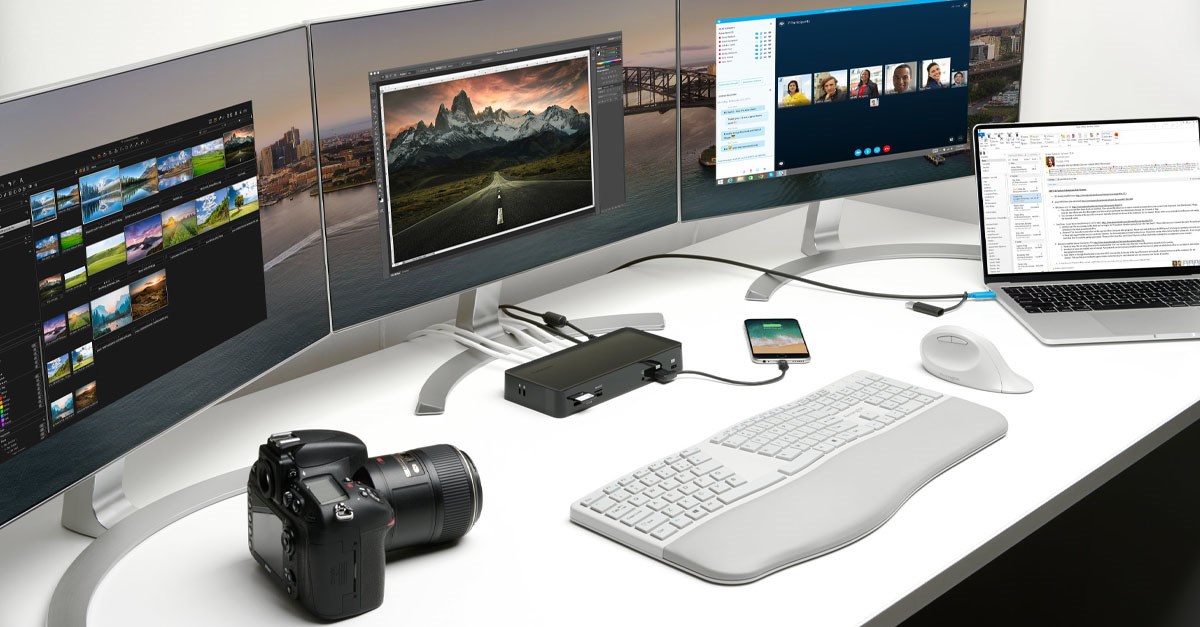
En este blog, hablaremos de los dos escenarios principales (o casos de uso) y de cómo puede configurar monitores dobles para más de una visualización mientras utiliza un nuevo dispositivo MacBook Pro o Air con el conjunto de chips M1.
Caso de uso 1: ya tiene un Docking Station
Si ha configurado su escritorio o estación de trabajo con un Docking Station con Modo Alt USB-C, Thunderbolt 3 o Thunderbolt 4, ampliar sus capacidades de visualización es tan sencillo como descargar el último controlador de DisplayLink para macOS. Una vez que haya actualizado el controlador, puede utilizar un adaptador de video de DisplayLink con puerto USB-A para conectar los monitores adicionales.
Si utiliza el último software adaptador de video de DisplayLink, puede usar su Docking Station actual para conectar hasta cinco pantallas a su MacBook M1. Si tiene algún problema después de actualizar el software de macOS, asegúrese de consultar nuevamente a DisplayLink para comprobar que la última versión del software esté instalada.
Caso de uso 2: no tiene un Docking Station y no quiere utilizar un adaptador
Si no ha usado un Docking Station en el pasado y no quiere utilizar un adaptador adicional, Kensington tiene una gama de Docking Stations con DisplayLink con puerto USB-C disponibles. Como estos productos aprovechan la tecnología DisplayLink, no necesitará un adaptador adicional para conectar varias pantallas.
Una vez que decida qué Docking Station con DisplayLink se adapta a su instalación, solo tiene que descargar el último software de DisplayLink. Entre los Docking Stations con DisplayLink de Kensington se encuentran los siguientes:
- Docking Station SD4700P (10 puertos) para video para monitores dobles de 2K, con 60 W de carga y 5 Gbps
- Docking Station SD4780P (12 puertos) para video para monitores dobles de 4K, con 100 W de carga y 10 Gbps
Nuevamente, si tiene algún problema después de actualizar macOS, debe consultar a DisplayLink e instalar la última versión del software. Con una de las soluciones de Docking Station enumeradas anteriormente, puede ampliar la capacidad de visualización externa a varios monitores, lo que se traduce en productividad con su configuración M1. Con un Docking Station con DisplayLink, obtendrá compatibilidad con toda su instalación sin necesidad de adaptadores especiales o soluciones complejas.
Compatibilidad nativa para una única visualización con dispositivos MacBook Pro y Air
La decisión de Apple de ofrecer compatibilidad para una visualización nativa única fue difícil de entender. Es posible que se deba a un problema de diseño, ya que la compañía sigue sin decir por qué ha optado por esta vía. Muchos usuarios que adquirieron uno de los dispositivos de la gama M1 del MacBook Pro o del MacBook Air se apresuraron a acudir a los foros de Internet para dejar constancia de su sorpresa.
El único dispositivo compatible con más de una visualización nativa es el Mac Mini M1. Aun así, sólo admite dos monitores externos (probablemente porque no tiene su propia pantalla integrada incluida). Para cualquier otro dispositivo M1, los usuarios tendrán que ser un poco creativos si sus configuraciones de escritorio utilizan más de un monitor externo.
Incluso con los últimos cambios en la arquitectura del chip subyacente de Apple, puede utilizar su nuevo MacBook con varios monitores externos.
Maximizar la productividad con el nuevo MacBook M1
Los que utilizamos los MacBooks para trabajar hemos confiado en su innovación para agilizar nuestros flujos de trabajo y conseguir nuevas eficiencias. Los nuevos MacBooks M1 integran múltiples funciones en un único conjunto de chips de alto rendimiento que va más allá de los procesadores del pasado.
Por si fuera poco, este nuevo diseño viene con un rendimiento sin precedentes, proporcionando un procesamiento de vídeo 3,9 veces más rápido y un procesamiento de imágenes 7,1 veces más rápido.
MacBooks M1 2021
El nuevo MacBook Pro 2021 con el chip Pro M1 ahora admite más de un monitor. Kensington tiene cubiertos estos nuevos MacBooks con una gama de soluciones líderes en el sector. Por destacar algunas grandes opciones, nuestro Docking Station SD5600T Thunderbolt™ 3 admite hasta dos monitores de 4K a 60 Hz, una velocidad de transferencia de datos de hasta 40 Gbps y mucho más. Si busca la última solución tecnológica disponible para combinarla bien con su nuevo MacBook M1 2021, nuestro Docking Station SD5700T Thunderbolt™ 4 es la opción ideal. Este Docking Station también admite hasta dos monitores de 4K a 60 Hz, así como también una velocidad de transferencia de datos de 40 Gbps. Lo que añade, sin embargo, son tres puertos Thunderbolt 4 de conexión descendente, que permiten ampliar aún más el escritorio a la mayor velocidad posible.